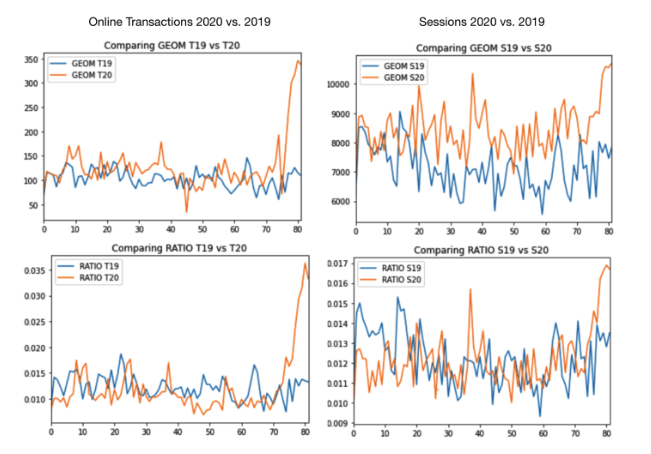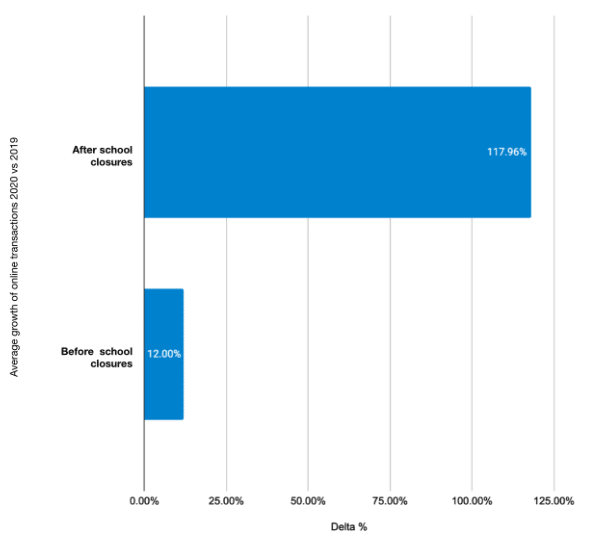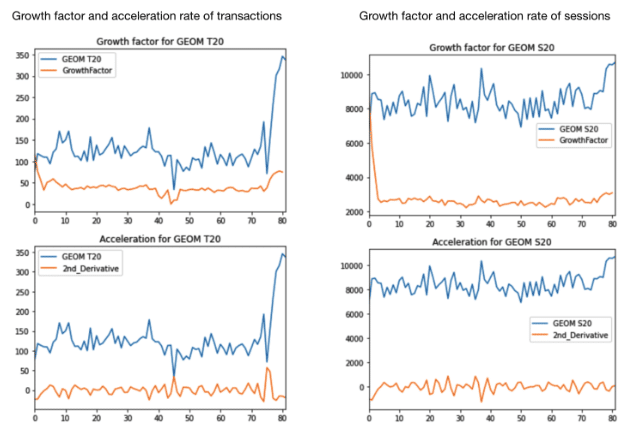Data Scientist
COVID-19 Boosts E-commerce by 118% in Quebec
Data Scientist
-
The Data Science & Analytics team at Adviso conducted a study to observe the impact of the COVID-19 crisis on the online behaviour of Quebec consumers.
-
Our results show an abnormally significant growth in e-commerce transitions, a 118% increase compared to the same period in 2019.
-
The predictive data available at this time allow us to believe that this growth has stabilized.
COVID-19 is turning our world upside down, from public health to the economy. Global measures, such as social distancing and the closure of non-essential business, have quickly and dramatically disrupted our lifestyles.
One of the most transformed behaviours is consumer purchasing. With limited access to brick and mortar shopping and the potential danger of going outside, e-commerce has become the top alternative of choice.
Since the beginning of this crisis, media outlets have reported that e-commerce giants like Amazon and Ebay have experienced rapid growth in recent weeks. Amazon also recently announced 100,000 new job openings in the United States in an effort to respond to the extreme demand generated by the pandemic.
Is this growth in online sales the case for all businesses, including those with physical locations? We suspected the answer was probably yes, but for the moment, there are few large-scale empirical studies on the issues.
A study was recently conducted by WITHIN to identify the e-commerce activity of an anonymous sample of their customers in the United States. The analysis examined the change in online revenue and conversion rates for different industries in February and March, comparing data from 2020 and 2019. Surprisingly, the results showed a trend contrary to the one suggested by Amazon and Ebay. This analysis revealed a significant drop in revenue and conversion rate, both for business customers with physical locations and for online-only businesses. The results may have been influenced by the drop in demand for certain products as a result of social distancing measures. The study also indicated a significant drop in digital media investment by American companies since the beginning of the crisis.
A second study, conducted by ChannelAdvisor, looked at changes in behaviour by consumption category, at GMV (Gross Marketplace Value) level. Unfortunately, the results of this study reveal little about the impact of the pandemic on online consumption on a broad scale, and is also focused exclusively on the United States.
The answers concerning COVID-19’s impact on e-commerce in Quebec have been missing, and the results from different sources (mostly American) were divergent. Our team at Adviso identified its mission: Analyze e-commerce behaviour of Quebec consumers using data from our own customers in Google Analytics. We have drawn up a sample over more than twenty Quebec brands, driven by one key scientific question: Has COVID-19 caused significant e-commerce growth in Quebec? If so, what is the magnitude of this impact?
The data source
The Google Analytics accounts chosen for this study were deliberately selected in order to build a diverse sample of retail industries, excluding tourism and travel. In choosing which accounts to analyze, the goal was to avoid the bias of companies offering essential goods, which could influence the results too strongly. In keeping a balance between companies providing both essential and non-essential products and services, we aimed to reduce the noise in our analysis. Without revealing the industries studied, to keep our clients’ anonymity, these accounts were selected in a way that balances the weight of each industry included in this study.
Our goal was to analyze the e-commerce behaviour of Quebec consumers through all of their consumption habits. In order to highlight the potential changes in behaviour, we deliberately excluded companies that were already 100% online from this study. The selection criteria were as follows:
- The business must have a physical distribution channel.
- The business must be capable of completing online transactions on its website.
The last criteria was subject to statistical confluence. The sample size we selected had a solid equilibrium between businesses which depended solely or partially on external distribution partners (ex: Walmart) and businesses which had their own points of sale (ex. A business with its own stores).
In this study, the period analyzed consisted of the 82 first days of 2020 from January 1st and is compared with the same period in 2019. The key metrics used were the volume of daily transactions and the volume of daily sessions.
Results
We wanted to observe if, from the moment of the announcement of school closures in Quebec, abnormal changes in online purchasing behavior took place. If so, were these changes proven to be mathematically significant when compared to the same period of the previous year?
According to our calculations, it is indeed possible to notice significant change in behavior in terms of online transactions. We can also observe a change that is still significant, but relatively minor, in the volume of sessions across all of the sample sites.

We also found that the sequential distribution is very similar for the two transformations, both the geometric mean and the daily mean ratio. According to the alternative ratio analysis, the effect of this change is also apparent for transactions, but somewhat less pronounced for session volume.
Hypothetically, it is possible that a good number of consumers already had the habit of visiting the websites in our sample prior to visiting the brick and mortar location. However, with the current reality, these same consumers possibly decided to make their purchases directly through the website as a result of social distancing measures.
Interpreting the results
All of our calculations allow us to answer our key question: The current COVID-19 pandemic has indeed generated significant growth in e-commerce in Quebec! More specifically, we are talking about a 118% increase in comparison to last year’s online transactions over the same period.

Thanks to the differences observed in sessions and transactions on our sample sites, we can see that online consumption for this period did indeed increase at a constant and significant rate. This is particularly true following the announcement of school closures in Quebec on March 13. We can also observe that consumers likely also increase the number of transitions per person with a positive acceleration. This means that the number of transitions per user is increasing faster (compared to 2019 after the schools were closed) than before. Additionally, as the number of transactions increases faster than the number of sessions, this may mean that an increasing share of sessions include more than one transaction.
Of course, we will continue to observe the e-commerce behavior of Quebec consumers in the coming weeks in order to paint a clearer portrait of this trend. It is likely that we will reach an inflection point in the curve of the number of transactions, which would translate into a negative average acceleration.
Above all, it is important, and very significant, to note that this aggressive growth in e-commerce was observed on all sites in this study, both for essential and non-essential goods and services.
Depending on the major economic disruptions caused by the pandemic, it is expected that businesses offering non-essential goods and services might experience a loss of growth speed over time, while the businesses which serve basic needs may experience an acceleration of the curve.
In another study, the Data Science & Analytics team at Adviso will publish further articles on this subject to see how the results evolve in reality. You can subscribe to our newsletter to receive updates.
Will this growth in e-commerce continue after the pandemic?
This study reflects a limited number of businesses. A deeper analysis would be required to paint a more robust picture of e-commerce transformations across Quebec. Our preliminary data indicates that the observed growth in e-commerce will stabilize. If this data represents an overall trend in Quebec consumer behaviour during a pandemic, we have to ask ourselves: How long can this last?
For now, it is not possible to answer this question scientifically. However, it is easy to imagine that the COVID-19 pandemic will leave permanent marks on our society. If you are interested, we recently held a virtual round table on this subject.
Many believe that e-commerce and digital marketing, like working from home, will become more widespread trends, even when the current health crisis subsides.
That said, at the moment, companies that can pivot toward digital, especially those which have been slow to do so, have every interest in acting quickly. The social distancing that saves lives also involves democratizing e-commerce.
Details on the mathematical approach of our study
Warning : This section serves to explain our scientific methodology. If you are unfamiliar with these mathematical concepts, you can skip this section.
The data studied was aggregated and transformed in two ways, complementary to each other, in order to validate the effect using more than one approach. On one hand, in order to normalize the heterogenous session and transaction volumes between the different companies in this sample, we calculated their respective geometric mean (rather than their standard arithmetic mean, which would not have taken into account the extreme proportions).
On the other hand, for each of the two metrics mentioned above, an arithmetic average of the daily ratio of each company was calculated for the 82-day period.
Using these two methods, we could cross-validate the results of the geometric mean in terms of the proportional amplitude of daily activity across all companies, while circumventing the problem of heterogeneity of volumes.
Finally, once the data had been transformed for each reference year for the entire sample, a time-series analysis was carried out using a standard growth factor calculation approach, as well as the measure of acceleration of the growth or decrease of the general e-commerce activity. Finally, the second derivative, the derivative of the derivative of a function, was measured to better understand the instantaneous acceleration of e-commerce activity, that is to say the speed at which the sales speed online has changed over time. This is what corresponds to the concavity of the system. The second derivative is expressed according to the following standard mathematical notation:
Details on the prediction of the stabilization of growth
In order to assess the extent of the change, the calculation of the second derivative makes it possible to predict, to a certain extent, if the trend will continue to grow, by evaluating whether the increase in the speed of transactions and sessions is positive, zero or negative. From the graphs below, we observe that at the beginning of the study period, the change in the number of sessions as a function of time S (t) experienced a significant increase, and that the acceleration was positive at this moment, Gs = S'(t) > 0 (growth) and as = S”(t) > 0.
However, after a while, the rate of change becomes stable, which can be noted in the trend of average acceleration. Detecting that as ~ 0 means that we are seeing growth, but at a constant rate.
On the other hand, if we focus the analysis on the change in behavior of transactions as a function of time T (t), we find that they experienced even more significant growth at the end of the study period, and overall, they show an increasing positive average over the entire study period. Gt = T ‘(t) > 0. This behavior is also observed in the analysis of the acceleration of transactions over time. We can observe that the mean is at = T” (t) > 0 throughout the study period.
Based on the transactions, taking into account the geometric mean, the acceleration is around 55, which means that the growth of the transaction base is around 55%. As for the ratio measurement, the acceleration is around 44%. For sessions, if we examine the calculations in base the acceleration is considerably weaker and drops to 22% based on the geometric mean and 19% based on the ratio.
By observing the growth factor and the second derivative of transactions and sessions, the presence of an abnormal change is confirmed. In addition, we can predict with caution that sudden growth will stabilize at the end of the period, but remains abnormally high, specifically at the transaction level.










